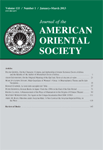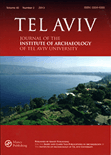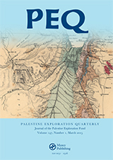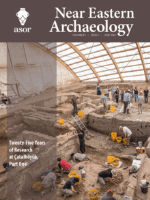
Zeitschrift fur Assyriologie und Vorderasiatische Archaologie
Scope & Guideline
Fostering Dialogue on the Archaeological Frontiers
Introduction
Aims and Scopes
- Ancient Textual Analysis:
The journal emphasizes the examination and interpretation of ancient texts, including cuneiform inscriptions, legal documents, and literary works, shedding light on the linguistic and grammatical features of these languages. - Archaeological Discoveries:
It highlights significant archaeological findings from the ancient Near East, providing insights into material culture, urbanization, and societal structures of the time. - Cultural and Religious Studies:
The journal explores themes related to the religious practices, rituals, and belief systems of ancient civilizations, including studies on mythology, ancestor worship, and cultic practices. - Interdisciplinary Approaches:
Emphasizing interdisciplinary research, the journal incorporates perspectives from history, linguistics, anthropology, and archaeology to provide comprehensive analyses of ancient Near Eastern societies. - Comparative Studies:
It includes comparative analyses between different ancient cultures, such as Hittite and Babylonian interactions, offering a broader understanding of cross-cultural exchanges.
Trending and Emerging
- Interdisciplinary Research:
There is a notable increase in interdisciplinary studies that combine archaeology, anthropology, and linguistics, reflecting a modern trend towards holistic approaches to understanding ancient societies. - Cultural Exchange and Interaction:
Recent papers emphasize the interactions between different cultures, such as Hittite and Babylonian exchanges, highlighting the complexities of ancient diplomacy and trade relationships. - Focus on Everyday Life and Societal Practices:
Emerging research themes focus on everyday life, including dietary practices, social structures, and economic activities, providing a more nuanced view of ancient civilizations beyond elite narratives. - Modern Interpretations of Ancient Texts:
There is a growing trend towards reinterpreting ancient texts with contemporary theoretical frameworks, such as gender studies and post-colonial perspectives, to uncover new meanings and implications. - Digital Humanities and Textual Analysis:
The integration of digital tools and methodologies in the analysis of ancient texts is on the rise, facilitating new avenues for research and accessibility to data.
Declining or Waning
- Traditional Historical Narratives:
Research focusing solely on traditional historical narratives without interdisciplinary connections has become less prominent, as scholars increasingly seek to integrate archaeological findings with textual analysis. - Overly Specialized Linguistic Studies:
Papers that delve into highly specialized linguistic features without broader implications or connections to cultural or historical contexts have waned, as there is a growing preference for studies that contextualize language within societal frameworks. - Limited Scope of Lesser-Known Texts:
There has been a decline in the exploration of lesser-known or obscure texts, as the focus has shifted toward more significant and impactful discoveries that can contribute to a broader understanding of ancient societies.
Similar Journals

ZEITSCHRIFT FUR AGYPTISCHE SPRACHE UND ALTERTUMSKUNDE
Illuminating Egypt's Linguistic and Cultural HeritageZEITSCHRIFT FUR AGYPTISCHE SPRACHE UND ALTERTUMSKUNDE, published by Walter de Gruyter GmbH, is a preeminent journal in the field of Egyptology, archaeology, and history. With roots tracing back to 1863, the journal has made significant contributions to the understanding of ancient Egyptian language and culture through rigorous scholarship and a commitment to academic excellence. The journal is subscribed to both print and digital formats, offering comprehensive access to a diverse range of critical research articles and reviews that appeal to researchers, students, and professionals alike. Presenting a unique blend of linguistic, historical, and archaeological perspectives, the journal has maintained a steady presence in academia despite fluctuating publication periods. In 2023, it ranks in the Q3 and Q4 quartiles across multiple categories, emphasizing its relevance and ongoing contributions to the understanding of ancient civilizations. Researchers looking to dive deep into the intricacies of Egypt's linguistic heritage and cultural contexts will find this journal an invaluable resource.

OLBA
Cultivating a Community of Archaeological InquiryOLBA is a distinguished journal in the field of archaeology, published by Mersin University Publications Research Center Cilician Archaeology in Turkey. With an ISSN of 1301-7667, this academic journal has been a platform for scholarly discourse from 2009 to 2014 and again from 2016 to 2019, with a recent volume published in 2022. Although it is currently categorized in the fourth quartile (Q4) for both Arts and Humanities and Social Sciences within archaeology, OLBA continues to contribute significantly to the global archaeology community. It serves as an essential resource for researchers, professionals, and students interested in the diverse aspects of archaeological studies and cultural heritage. Despite not being an open-access journal, OLBA strives to disseminate knowledge effectively, aiding in the exploration of ancient civilizations and the rich tapestry of human history. Its Scopus rankings, placing it in the bottom percentiles, demonstrate the ongoing need for the community to support and engage with the journal to enhance its visibility and impact in the archaeological domain.

ZEITSCHRIFT DES DEUTSCHEN PALASTINA-VEREINS
Illuminating the Past to Inform the PresentZEITSCHRIFT DES DEUTSCHEN PALASTINA-VEREINS is a distinguished academic journal published by VERLAG OTTO HARRASSOWITZ, focusing on interdisciplinary research in archaeology, cultural studies, history, and religious studies. With an ISSN of 0012-1169, this periodical has gained recognition for its valuable contributions to the understanding of historical and contemporary issues related to the Levant region, making it an essential resource for researchers, professionals, and students fascinated by these disciplines. The journal's performance in the academic community is bolstered by its Q2 and Q3 quartile rankings across various subject categories in 2023, including significant placements in cultural studies and religious studies, reflecting its impact and relevance. ZEITSCHRIFT DES DEUTSCHEN PALASTINA-VEREINS not only serves as a platform for scholarly discourse but also engages with current debates and methodologies, fostering a deeper appreciation for the complexities of Palestinian studies and contributing to a vibrant academic landscape. While the journal is not open access, it remains a critical venue for disseminating cutting-edge research and perspectives.

ARCHAEOLOGY
A Scholarly Journey Through Time and CultureARCHAEOLOGY is a distinguished peer-reviewed journal published by the Archaeological Institute of America, focusing on the multifaceted aspects of archaeological research and its relevance to contemporary society. Established in 1966, this journal serves as a critical platform for scholarly discourse in the field, showcasing innovative findings, theoretical advancements, and methodological discussions related to archaeology. While it maintains a Q4 ranking within the disciplines of archaeology and arts and humanities, its contributions remain valuable for those engaging in archaeological studies or seeking to understand historical and cultural narratives. The journal is accessible in print, with an ISSN of 0003-8113 and an E-ISSN of 1943-5746, ensuring that a wide audience can benefit from its insights. Although currently not classified as Open Access, the meticulous peer-review process ensures a high standard of academic rigor, making it an essential source for researchers, professionals, and students alike who are dedicated to exploring the past through archaeological lenses.

JOURNAL OF THE AMERICAN ORIENTAL SOCIETY
Cultivating Understanding of Asian PhilosophiesThe JOURNAL OF THE AMERICAN ORIENTAL SOCIETY, published by the American Oriental Society, is a prestigious academic journal based in the United States that serves as a vital resource for researchers and scholars engaged in the fields of Asiatic studies, cultural studies, and broader humanities. Established to foster scholarly communication, this journal presents rigorous peer-reviewed articles and critical analyses that explore the diverse cultural, historical, and linguistic dimensions of the Orient. With an impact factor reflecting its scholarly significance, it occupies a Q3 position in Arts and Humanities (miscellaneous) and a Q2 ranking in Cultural Studies as of 2023. Although it does not currently offer open access, the journal maintains a strong reputation for its scholarly contributions, making it an essential platform for disseminating research findings. By bridging gaps in knowledge and fostering interdisciplinary dialogue, the JOURNAL OF THE AMERICAN ORIENTAL SOCIETY remains a cornerstone for those committed to the exploration of Asian cultural heritage and philosophy, enriching the academic community's understanding in these vital fields.

Tel Aviv-Journal of the Institute of Archaeology of Tel Aviv University
Unearthing Insights, Bridging CulturesTel Aviv-Journal of the Institute of Archaeology of Tel Aviv University, published by Routledge Journals, Taylor & Francis Ltd, stands as a premier academic publication in the fields of archaeology, cultural studies, and history. Established in 1974, this journal has significantly contributed to archaeological scholarship and fosters a rich dialogue among researchers and practitioners worldwide, particularly in the context of the Middle East. With a remarkable Q1 ranking in multiple categories, including Archaeology and Cultural Studies, it is recognized for its high-quality, impactful research. The journal's audience consists of academics, professionals, and students eager to explore new findings and interdisciplinary approaches. While it does not operate under an open-access model, its scholarly articles are pivotal for advancing knowledge and understanding in archaeology and related fields, thus continuing its legacy as a vital resource for cutting-edge research up to 2024.

Palestine Exploration Quarterly
Illuminating Cultural Narratives through Scholarly InsightPalestine Exploration Quarterly, published by Routledge Journals, Taylor & Francis Ltd, is a leading academic journal that has been at the forefront of archaeological, historical, and cultural studies concerning Palestine since its inception in 1865. With an impressive Q1 ranking in multiple categories including Archaeology, History, Religious Studies, and Visual Arts and Performing Arts, the journal is recognized for its rigorous peer-reviewed content that significantly contributes to the understanding of cultural heritage and societal dynamics in the region. The UK-based journal offers an array of scholarly articles, reviews, and reports aimed at researchers, professionals, and students in the humanities and social sciences. With a strong focus on advancing knowledge and fostering academic discourse, the Palestine Exploration Quarterly remains an invaluable resource for those engaged in the exploration and interpretation of Palestine's rich history and heritage, now accessible through various academic libraries worldwide.

NEAR EASTERN ARCHAEOLOGY
Bridging Past and Present Through Archaeological InquiryNEAR EASTERN ARCHAEOLOGY, published by University of Chicago Press, is a premier journal dedicated to the field of archaeology, particularly focusing on the rich cultural heritage and archaeological findings of the Near East. With an ISSN of 1094-2076 and an E-ISSN of 2325-5404, this esteemed publication provides a vital platform for scholars and practitioners to share their research, insights, and discoveries. The journal holds an impressive ranking in the Q1 quartile for both Archaeology and History in 2023, reflecting its significant impact within these fields and a robust history of scholarly contribution. The journal has been pivotal in shaping discussions around archaeological methodology, theory, and contemporary issues from 2002 to 2024, as it continues to reach a wide audience through various access options. With Scopus rankings placing it in the top percentiles for both History and Archaeology, NEAR EASTERN ARCHAEOLOGY represents an essential resource for researchers, professionals, and students alike, fostering the exploration and understanding of the region's archaeological narrative.

Cartagine-Studi e Ricerche
Unveiling the past through innovative research.Cartagine-Studi e Ricerche is a distinguished academic journal published by UNIV STUDI CAGLIARI, dedicated to advancing the fields of Archaeology, Classics, and History. With an Open Access format since its inception in 2016, this journal ensures that scholarly research is freely available to a global audience, fostering knowledge dissemination and collaboration among researchers, professionals, and students. Based in Italy, it occupies a vital place in the academic community, holding a Q3 ranking in each of its categories for 2023, showcasing its relevance and impact in the disciplines it covers. Scopus rankings further validate its quality, with impressive percentiles reflecting its significant contributions to the landscape of arts and humanities. Spanning converged years from 2019 to 2024, Cartagine-Studi e Ricerche serves as a crucial resource for those engaged in the study of ancient cultures and historical contexts, inviting innovative research and critical discussions that shape our understanding of the past.

Veleia
Connecting Scholars to Shape the Future of History and ArtVeleia is a distinguished academic journal published by the Universidad del País Vasco, specifically from the Department of History, Art, and Music. This journal serves as a vital platform for the dissemination of scholarly research in the fields of history and archaeology, with a particular focus on the cultural and historical narratives of the Basque region and beyond. With a commitment to academic rigor, Veleia facilitates the exchange of innovative ideas and methodologies among researchers, professionals, and students alike. Although currently not open access, the journal aims to contribute significantly to its field by promoting interdisciplinary dialogue and fostering a deeper understanding of historical contexts. By publishing high-quality, peer-reviewed articles, Veleia plays a crucial role in advancing the academic discourse surrounding history and the arts in contemporary scholarship.